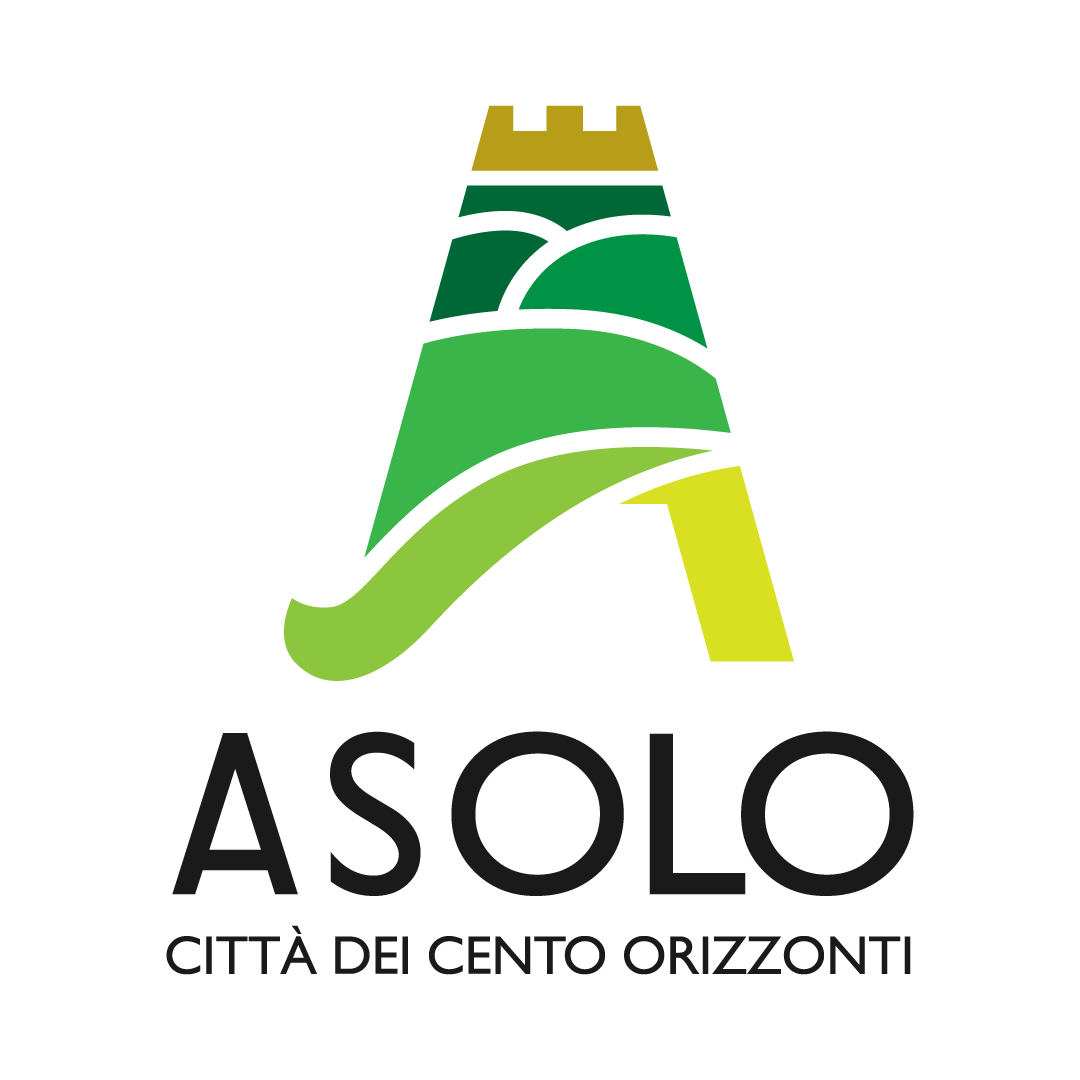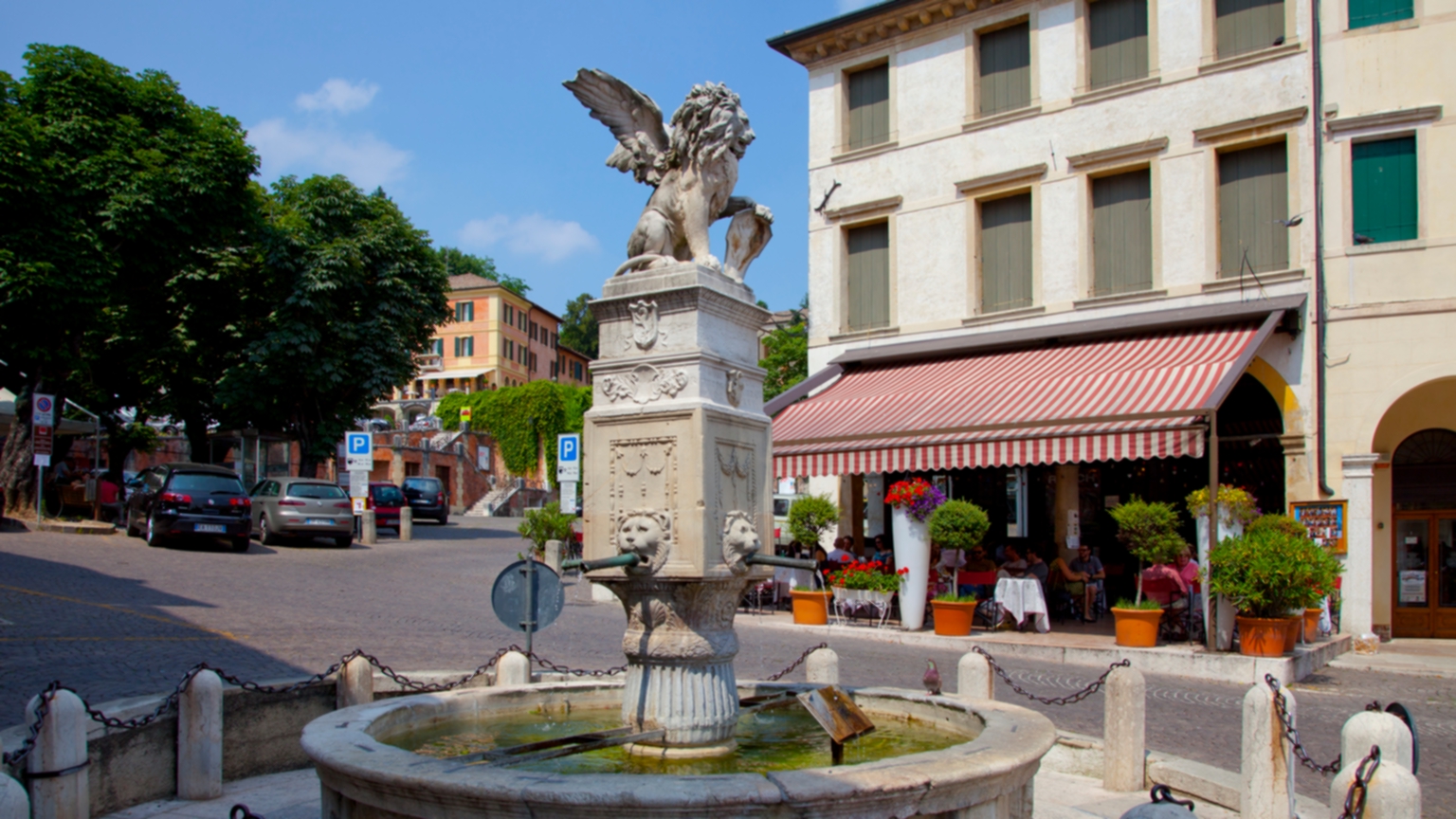Short itinerary (1,5-2 hours)
For the visitor who wants to linger in the center of Asolo, this itinerary of about two hours allows you to discover the important treasures of art and history of the village that are enclosed and protected within the medieval city walls. In the ups and downs of the main streets, in a short walk you will savor the millenary essence of the village without ever straying too far from the lion of San Marco that quietly watches over the main square.
Fontana Maggiore (1), Cattedrale (2), Cappella del Cristo (3), Museo Civico (4), Palazzo della Ragione (5), Castello di Caterina Cornaro (6), Teatro Duse (7), Villa Contarini detta Degli Armeni (8), Palazzo Beltramini (9), Porta di Santo Spirito (10), Casa Duse (11), Casa Gotica (12), Piazza Brugnoli (13), Villa Pasini Scotti (14), Rocca (15), Bot (16)
1) The first steps of the walk in the village of Asolo must have the symbolic monument of the square as a starting point: let’s start from the navel of the historic center, from the Fontana Maggiore (1). Until a few years ago, still fed by the millenary Roman aqueduct, the fountain has always been a meeting point for the life of the Asolo people and a memory of the history of the city and the lion of San Marco, who, sitting as a sign of peace, protects the coat of arms of Asolo, it is a reconstruction of 1800 by Antonio dal Zotto to reintegrate the original one destroyed in 1797 when Napoleon’s French troops arrived. This date, 1797, put an end to the Podesteria of Asolo, cutting the umbilical cord that kept the village tied for more than four hundred years, from 1388, to the Serenissima Republic of Venice. But let’s go back to the fountain and follow the lion’s gaze to begin to loop through the streets of the center. We take Via Robert Browning, an English poet of the late 1800s who with the term “asolando” wanted to describe his habit of walking with a calm soul and without a precise destination, enjoying the beauty of the village.
2) We resist the temptation to continue to the end of the street protected by the arcades and cross the road to skirt the side of the Cathedral (2). If we turn towards the arcades just for a moment we will be able to admire the marvelous facade of the Cesana, Polo and Martinelli palaces, of which a pale impression remains by now. On the base of one of the pillars, a plaque commemorates the terrible earthquake in Santa Costanza that devastated the Asolo area on 25 February 1695.
3) We continue and immediately on the left we find the entrance to a tiny chapel, entitled Chapel of Christ (3), a place of intimate devotion of the Asolans. Exactly opposite we can enter the Cathedral from the ancient porch of the ‘400, the Cathedral, dedicated to Santa Maria Assunta, preserves inside works of great historical and artistic importance such as the altarpieces by Lorenzo Lotto and Jacopo da Ponte in the left aisle or the 16th century baptismal font in the Chapel of the Blessed Sacrament in the right aisle, a gift from Caterina Cornaro to the city
4) Leaving the main entrances, in front of us rises the building that was once the bishop’s palace and now houses the sections of the Civic Museum (4), a place that room after room brings to life the centuries-old history of Asolo from archaeological finds to the precious paintings up to the memory of the women who made the name of the village international: Caterina Cornaro, Queen of Cyprus, Armenia and Jerusalem, the Divine Eleonora Duse and the eccentric English traveler Freya Stark.
5) To reach the Museum just go up the short staircase that leads to Piazza Garibaldi. At the corner we will find the IAT (Tourist Information and Reception Office) where we can stock up on material to learn more about Asolo and the whole area. Leaving the office, the Palazzo della Ragione (5) rises on the left, a place of public administration during the Venetian Podesta office. The building is divided into the upper Sala della Ragione where a precious marble by Canova is kept; on the lower floor there is the Loggia del Capitano, a completely covered part of the Asolo square, memories of ancient Asolo buildings and places that have been abandoned or demolished over the centuries.
6) Going up along Via Cornaro we approach the spur of rock that supports the Castle, after the short climb we take the cobblestone that climbs to the left and enter through the large door in the area of the Castle of Caterina Cornaro (6). Inside the building, evidently remodeled in the last century, the Duse Theater (7) is now housed in what was once the throne and reception room.
7) Walking in the open area from a small terrace under the arch of the medieval walls that protect the Castle, you can admire the roofs of Asolo, which are so reminiscent of Venice; climbing the steep staircase of the Reata Tower you can see other enchanting views of the city of a hundred horizons, as well as from the short panoramic walk that looks to the south or from the Belvedere della Specola to the north that offers a view of the buildings that wind along Via Santa Caterina and in the distance it gives the best view of the Monte Grappa massif. On the hill on the left stand the silhouettes of the Fresco of Villa Contarini known as Degli Armeni (8) and the particular dome of its oratory.
8) We resume our steps and at the end of the cobblestones of the Castle we find ourselves in front of Piazza D’Annunzio. The building with massive white columns is Palazzo Beltramini (9), seat of the Town Hall, retouched in the 1700s by Giorgio Massari. On the facade of the building north of the square, at the intersection of four balconies, the faded image of the Duce’s face covered by the helmet recalls one of the least glorious moments in the history of Asolo and Italy.
9) We go down the silent Via Canova until we reach the Porta di Santo Spirito or Santa Caterina (10), the fourteenth-century access to the city walls. Casa Duse (11) is the two-colored building, red and white, which rests on the arch and on which a plaque written by Gabriele D’Annunzio has been affixed to commemorate the Asolan stay of the Divine. The room that Eleonora Duse used to live in is the room whose windows open right above the arch. We go up Via Canova, leave Piazza D’Annunzio on the right and continue straight along Via Dante. At the end of the street we look up to the right on the ancient Gothic House (12). Let’s stop in the shadow of the chestnut trees in Piazza Brugnoli (13) to admire the wonderful Villa Scotti Pasini (14) dominated on the summit of Monte Ricco by one of the faces of the Rocca (15).
10) We go down Via Roma, imagining the splendor of the Roman baths whose remains rest under the porphyry mantle of Piazza Brugnoli and whose waters were fed by natural sources from the hills conveyed into the Bot (16). In front of us we return to see the Fontana Maggiore, the starting and ending point of our itinerary.

